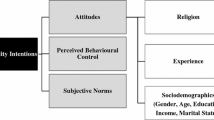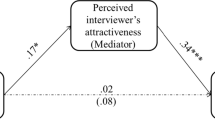Abstract
The current studies used the Perceptions of Dating Infidelity Scale (PDIS), which identifies attitudes toward three types of behaviors indicative of cheating: Ambiguous, Deceptive, and Explicit behaviors, to predict actual infidelity behaviors. Participants reported their attitude toward these behaviors and then reported their willingness to engage in these behaviors with a hypothetical target (Study 1) and reported actually engaging in these behaviors over the course of one month (Study 2). Study 1 showed that attitudes for Ambiguous and Deceptive behaviors significantly predict a willingness to engage in these behaviors with a hypothetical target. Study 2 showed that attitudes toward Ambiguous behaviors significantly predict actual engagement in Ambiguous behaviors during the course of one month.
Similar content being viewed by others
Notes
Because the results reported in Study 1 were part of a larger experiment in which participants completed a variety of tasks, completion time was not recorded. The sole purpose of Study 2, however, was to examine how infidelity attitudes predicted actual behavior. Thus, the completion time gathered in Study 2 provides insight as to whether participants were motivated and attentive when completing the questionnaires.
References
Aron, A., Aron, E. N., & Smollen, D. (1992). Inclusion of other in the self and the structure of interpersonal closeness. Journal of Personality and Social Psychology, 63, 596–612.
Atkins, D. C., Baucom, D. H., & Jacobson, N. S. (2001). Understanding infidelity: correlates in a national random sample. Journal of Family Psychology, 15, 735–749.
Barta, W. D., & Kiene, S. M. (2005). Motivations for infidelity in heterosexual dating couples: the roles of gender, personality differences, and sociosexual orientation. Journal of Social and Personal Relationships, 22, 339–360.
Buss, D. M., & Shackelford, T. K. (1997). Susceptibility to infidelity in the first year of marriage. Journal of Research in Personality, 31, 193–221.
Buunk, B. P. (1995). Sex, self-esteem, dependency and extradyadic sexual experience as related to jealousy responses. Journal of Social and Personal Relationships, 12, 147–153.
Cacioppo, J. T., & Petty, R. E. (1982). The need for cognition. Journal of Personality and Social Psychology, 42, 116–131.
Conner, M. T., Perugini, M., O’Gorman, R., Ayres, K., & Prestwich, A. (2007). Relations between implicit and explicit measures of attitude and measures of behavior: evidence of moderation by individual difference variables. Personality Social Psychology Bulletin, 33, 1727–1740.
Daly, M., & Wilson, M. (1988). Evolutionary social psychology and family homicide. Science, 242, 519–524.
Davidson, A. R., & Jaccard, J. J. (1979). Variables that moderate the attitude-behavior relation: results of a longitudinal survey. Journal of Personality and Social Psychology, 37, 1364–1376.
Drigotas, S. M., Safstrom, C. A., & Gentilia, T. (1999). An investment model prediction of dating infidelity. Journal of Personality and Social Psychology, 77, 509–524.
Feldman, S. S., & Cauffman, E. (1999). Your cheatin’ heart: attitudes, behaviors, and correlates of sexual betrayal in late adolescents. Journal of Research on Adolescence, 9, 227–252.
Glass, S., & Wright, T. L. (1985). Sex differences in type of extramarital involvement and marital dissatisfaction. Sex Roles, 12, 1101–1119.
Glass, S., & Wright, T. L. (1992). Justifications for extramarital relationships: the association between attitudes, behaviors, and gender. Journal of Sex Research, 29, 361–388.
Hackathorn, J. (2009). Beyond touching: the evolutionary theory and computer mediated infidelity. The New School Psychology Bulletin, 6, 29–34.
Hall, J. H., & Fincham, F. D. (2009). Psychological distress: precursor or consequence of dating infidelity? Personality and Social Psychology Bulletin, 35, 143–159.
Johnson, R. E. (1970). Extramarital sexual intercourse: a methodological note. Journal of Marriage and the Family, 32, 449–456.
Lawson, A. (1988). Adultery: an analysis of love and betrayal. New York: Basic Books.
Lewandowski, G. W., Jr., & Ackerman, R. A. (2006). Something’s missing: need fulfillment and self-expansion as predictors of susceptibility to infidelity. The Journal of Social Psychology, 146, 389–403.
Lord, C. G., & Lepper, M. R. (1999). Attitude representation theory. In M. P. Zanna (Ed.), Advances in experimental social psychology (pp. 265–343). New York: Academic.
Lydon, J., Pierce, T., & O’Regan, S. (1997). Coping with moral commitment to long term dating relationships. Journal of Personality and Social Psychology, 73, 104–113.
Mattingly, B. A., Wilson, K., Clark, E. M., Bequette, A. W., & Weidler, D. J. (2010). Foggy faithfulness: relationship quality, religiosity, and the romantic cheating scale in an adult sample. Journal of Family Issues, 31, 1465–1480. doi:10.1177/0192513X10362348.
Mattingly, B. A., Clark, E. M., Weidler, D. J., Bullock, M., Hackathorn, J., & Blankmeyer, K. (2011). Sociosexual orientation, commitment, and infidelity: a mediation analysis. Journal of Social Psychology, 151, 222–226. doi:10.1080/00224540903536162.
McIntyre, R. B., Paulson, R. M., Lord, C. G., & Lepper, M. R. (2004). Effects of attitude action identification on congruence between attitudes and behavioral intentions toward social groups. Personality and Social Psychology Bulletin, 30, 1151–1164.
Merkle, E. R., & Richardson, R. A. (2000). April). Digital dating and virtual relating: conceptualizing computer mediated romantic relationships. Family Relations, 49(2), 187–193.
Rusbult, C. E., Martz, J. M., & Agnew, C. R. (1998). The Investment Model scale: measuring commitment level, satisfaction level, quality of alternatives, and investment size. Personal Relationships, 5, 357–391.
Seal, D. W., Agostinelli, G., & Hannett, C. A. (1994). Extradyadic romantic involvement: moderating effects of sociosexuality and gender. Sex Roles, 3, 1–22.
Shackelford, T. K., & Buss, D. M. (1997). Cues to infidelity. Personality and Social Psychology Bulletin, 23, 1034–1045.
Sponaugle, G. C. (1989). Attitudes toward extramarital relations. In K. McKinney & S. Sprecher (Eds.), Human sexuality: the societal and interpersonal context (pp. 187–209). Westport: Ablex.
Tafoya, M. A., & Spitzberg, B. H. (2007). The dark side of infidelity: Its nature, prevalence, and communicative functions. In B. H. Spitzberg & W. R. Cupach (Eds.), The dark side of interpersonal communication (2nd ed., pp. 201–242). Lawrence Erlbaum Associates.
Thompson, A. P. (1983). Extramarital sex: a review of research literature. Journal of Sex Research, 19, 1–22.
Treas, J., & Geissen, D. (2000). Sexual infidelity among married and cohabiting Americans. Journal of Marriage and the Family, 62, 48–60.
Vangelisti, A. L., & Gerstenberger, M. (2004). Communication and marital infidelity. In J. Duncome, K. Harrison, G. Allan, & D. Marsden (Eds.), The state of affairs: Explorations in infidelity and commitment (pp. 59–78). Mahwah: Erlbaum.
Weis, D. L., & Felton, J. R. (1987). Marital exclusivity and the potential for future marital conflict. Social Work, 32, 45–49.
Whisman, M. A., Gordon, K. G., & Chatav, Y. (2007). Predicting sexual infidelity in a population-based sample of married individuals. Journal of Family Psychology, 21, 320–324.
Whitely, C. H., & Whitely, W. M. (1967). Sex and morals. New York: Basic Books, Inc.
Wicker, A. (1969). Attitudes versus actions: the relationship of verbal and overt behavioral responses to attitude objects. Journal of Social Issues, 25, 41–78.
Wiederman, M. W. (1997). Extramarital sex: prevalence and correlates in a national survey. Journal of Sex Research, 34(2), 167–175.
Wiederman, M. W., & Allgeier, E. R. (1993). Gender differences in sexual jealousy: adaptationist or social learning explanation? Ethology and Sociobiology, 14, 115–140.
Wiederman, M. W., & Hurd, C. (1999). Extradyadic involvement during dating. Journal of Social and Personal Relationships, 16, 265–274.
Wilson, K., Mattingly, B. A., Clark, E. M., Weidler, D. J., & Bequette, A. W. (2011). The gray area: exploring attitudes toward infidelity and the development of the Perceptions of Dating Infidelity Scale. Journal of Social Psychology, 151, 63–86.
Yarab, P. E., Allgeier, E. R., & Sensibaugh, C. C. (1999). Looking deeper: extradyadic behaviors, jealousy, and perceived unfaithfulness in hypothetical dating relationships. Personal Relationships, 6, 305–316.
Author information
Authors and Affiliations
Corresponding author
Rights and permissions
About this article
Cite this article
Hackathorn, J., Mattingly, B.A., Clark, E.M. et al. Practicing What You Preach: Infidelity Attitudes as a Predictor of Fidelity. Curr Psychol 30, 299–311 (2011). https://doi.org/10.1007/s12144-011-9119-9
Published:
Issue Date:
DOI: https://doi.org/10.1007/s12144-011-9119-9




